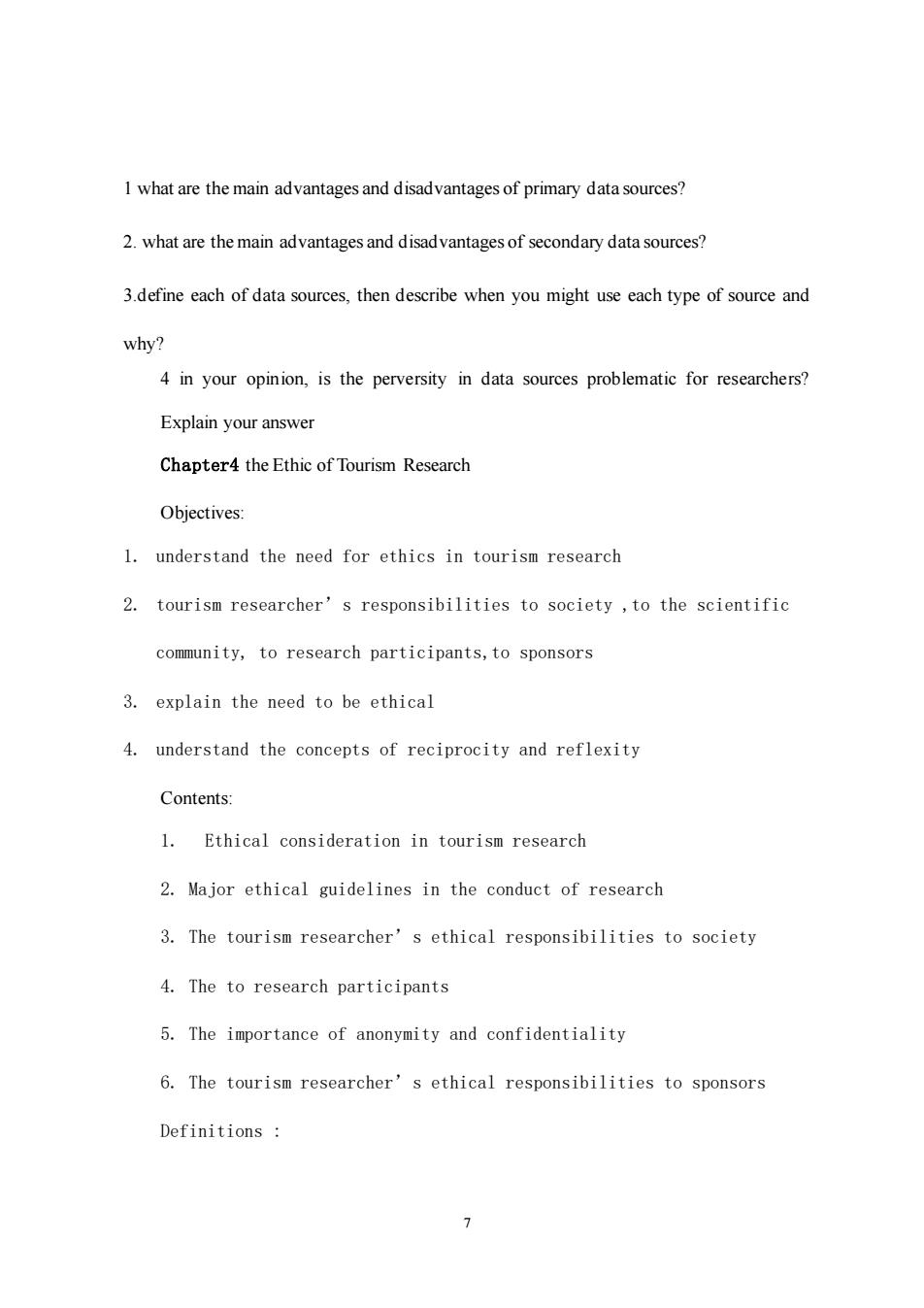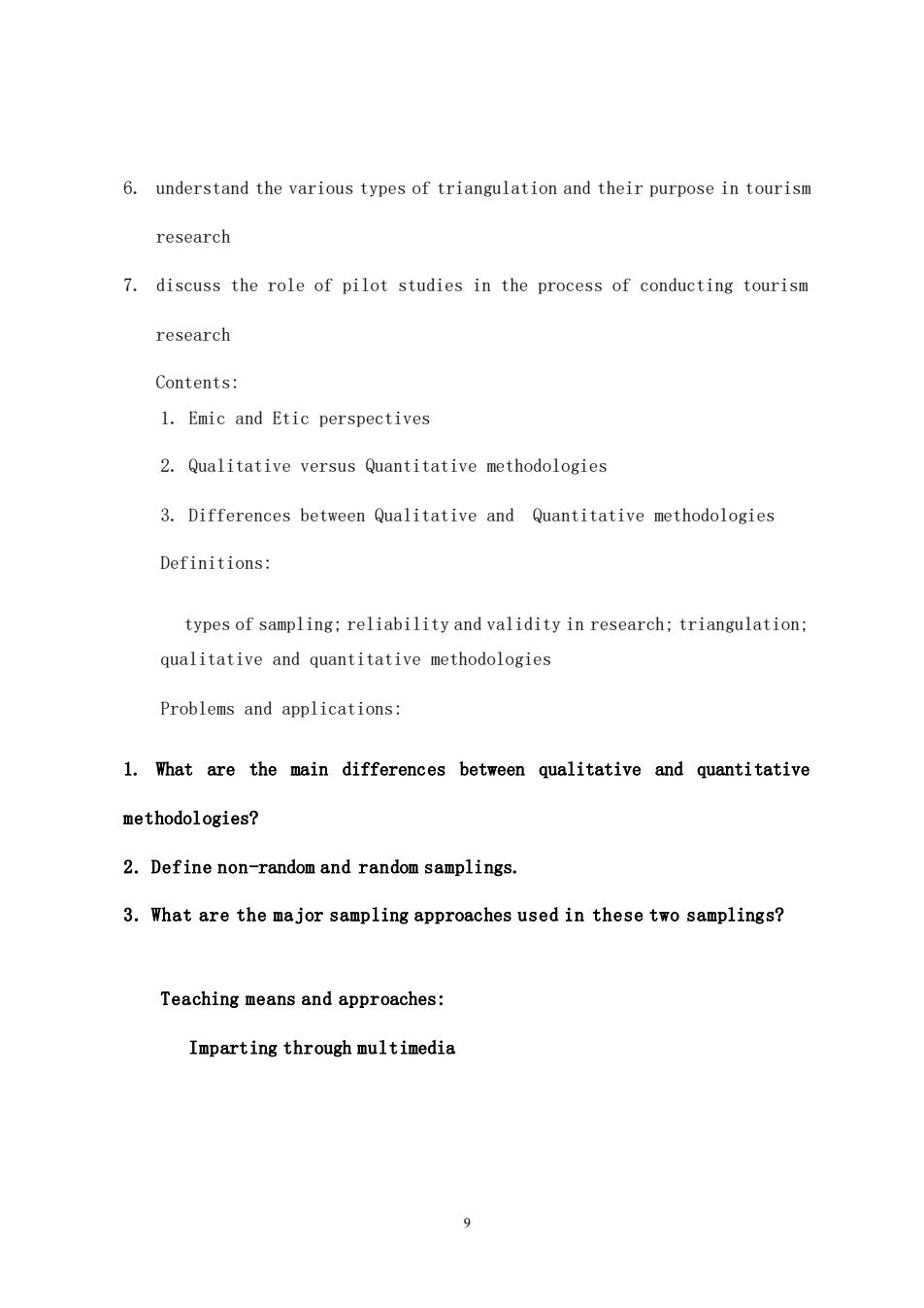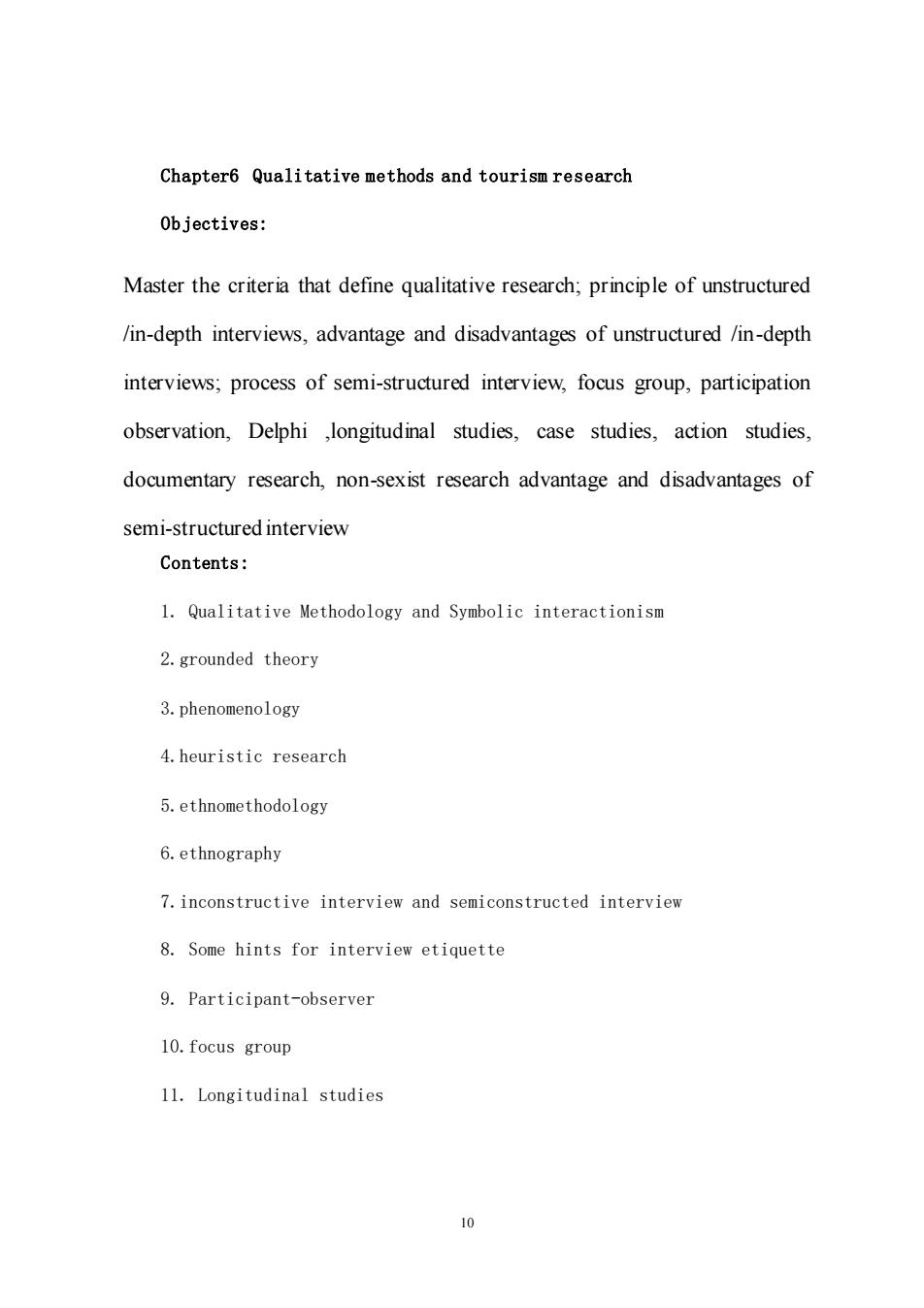
4.why is it necessary for a researcher to ensure that research projects are informed by the "right "theoretical paradigm? 5.Teaching means and approaches: 6. Imparting through multimedia Chapter3 Data Source for Tourism Research Objectives: 1.Describe the major primary and secondary data source for use in tourism research 2.Describe the advantages and disadvantages for primary and secondary data source for use in tourism research 3.Basic understanding of content analysis Contents: 1.two types of date source for tourism research 2.primary data soure for tourism research:advantages and disadvantages; 3.secondary data soure for tourism research:advantages and disadvantages; 4.key sources of secondary data for touism research. Definitions: primary data soure for tourism research secondary data soure for tourism research Problems and applications: 6
6 4. why is it necessary for a researcher to ensure that research projects are informed by the “right ”theoretical paradigm? 5. Teaching means and approaches: 6. Imparting through multimedia Chapter3 Data Source for Tourism Research Objectives: 1. Describe the major primary and secondary data source for use in tourism research 2. Describe the advantages and disadvantages for primary and secondary data source for use in tourism research 3. Basic understanding of content analysis Contents: 1.two types of date source for tourism research 2.primary data soure for tourism research:advantages and disadvantages; 3.secondary data soure for tourism research:advantages and disadvantages; 4.key sources of secondary data for touism research. Definitions: primary data soure for tourism research ;secondary data soure for tourism research Problems and applications:

1 what are the main advantages and disadvantages of primary data sources? 2.what are the main advantages and disadvantages of secondary data sources? 3.define each of data sources,then describe when you might use each type of source and why? 4 in your opinion,is the perversity in data sources problematic for researchers? Explain your answer Chapter4 the Ethic of Tourism Research Objectives: 1.understand the need for ethics in tourism research 2.tourism researcher's responsibilities to society,to the scientific community,to research participants,to sponsors 3.explain the need to be ethical 4.understand the concepts of reciprocity and reflexity Contents: 1.Ethical consideration in tourism research 2.Major ethical guidelines in the conduct of research 3.The tourism researcher's ethical responsibilities to society 4.The to research participants 5.The importance of anonymity and confidentiality 6.The tourism researcher's ethical responsibilities to sponsors Definitions
7 1 what are the main advantages and disadvantages of primary data sources? 2. what are the main advantages and disadvantages of secondary data sources? 3.define each of data sources, then describe when you might use each type of source and why? 4 in your opinion, is the perversity in data sources problematic for researchers? Explain your answer Chapter4 the Ethic of Tourism Research Objectives: 1. understand the need for ethics in tourism research 2. tourism researcher’s responsibilities to society ,to the scientific community, to research participants,to sponsors 3. explain the need to be ethical 4. understand the concepts of reciprocity and reflexity Contents: 1. Ethical consideration in tourism research 2. Major ethical guidelines in the conduct of research 3. The tourism researcher’s ethical responsibilities to society 4. The to research participants 5. The importance of anonymity and confidentiality 6. The tourism researcher’s ethical responsibilities to sponsors Definitions :

tourism researcher's ethical responsibilities Problems and applications: 1.What key items are ineluded in the Codes of ethies? 2.What information does the Informed consent need to provide? 3.Written assignment Two: Suppose you are doing a research on the application of a new service method in an amusement park,you will need to know the perspectives from both the customers and staff.Please compose an informed consent.Be sure that all the necessary information required in the consen should be included in your consent form.Take Figure 4.2 as an example,if needed. Teaching means and approaches: Imparting through multimedia Chapter5 Methodological considerations for tourism research Objectives: 1.describe the difference between emic and etic approach to data collection 2.explain the difference between qualitative and quantitative methodologies 3.explain the use of mixed method approach 4.distinguish between various types of sampling 5.outline the need for reliability and validity in research
8 tourism researcher’s ethical responsibilities Problems and applications: 1. What key items are included in the Codes of ethics? 2. What information does the Informed consent need to provide? 3. Written assignment Two: Suppose you are doing a research on the application of a new service method in an amusement park, you will need to know the perspectives from both the customers and staff. Please compose an informed consent. Be sure that all the necessary information required in the consent should be included in your consent form. Take Figure 4.2 as an example, if needed. Teaching means and approaches: Imparting through multimedia Chapter5 Methodological considerations for tourism research Objectives: 1. describe the difference between emic and etic approach to data collection 2. explain the difference between qualitative and quantitative methodologies 3. explain the use of mixed method approach 4. distinguish between various types of sampling 5. outline the need for reliability and validity in research

6.understand the various types of triangulation and their purpose in tourism research 7.discuss the role of pilot studies in the process of conducting tourism research Contents: 1.Emic and Etic perspectives 2.Qualitative versus Quantitative methodologies 3.Differences between Qualitative and Quantitative methodologies Definitions: types of sampling;reliability and validity in research;triangulation; qualitative and quantitative methodologies Problems and applications: 1.What are the main differences between qualitative and quantitative methodologies? 2.Define non-random and random samplings. 3.What are the major sampling approaches used in these two samplings? Teaching means and approaches: Imparting through multimedia 9
9 6. understand the various types of triangulation and their purpose in tourism research 7. discuss the role of pilot studies in the process of conducting tourism research Contents: 1. Emic and Etic perspectives 2. Qualitative versus Quantitative methodologies 3. Differences between Qualitative and Quantitative methodologies Definitions: types of sampling; reliability and validity in research; triangulation; qualitative and quantitative methodologies Problems and applications: 1. What are the main differences between qualitative and quantitative methodologies? 2. Define non-random and random samplings. 3. What are the major sampling approaches used in these two samplings? Teaching means and approaches: Imparting through multimedia

Chapter6 Qualitative methods and tourism research Objectives: Master the criteria that define qualitative research;principle of unstructured /in-depth interviews,advantage and disadvantages of unstructured /in-depth interviews;process of semi-structured interview,focus group,participation observation,Delphi ,longitudinal studies,case studies,action studies, documentary research,non-sexist research advantage and disadvantages of semi-structured interview Contents: 1.Qualitative Methodology and Symbolic interactionism 2.grounded theory 3.phenomenology 4.heuristic research 5.ethnomethodology 6.ethnography 7.inconstructive interview and semiconstructed interview 8.Some hints for interview etiquette 9.Participant-observer 10.focus group 11.Longitudinal studies 10
10 Chapter6 Qualitative methods and tourism research Objectives: Master the criteria that define qualitative research; principle of unstructured /in-depth interviews, advantage and disadvantages of unstructured /in-depth interviews; process of semi-structured interview, focus group, participation observation, Delphi ,longitudinal studies, case studies, action studies, documentary research, non-sexist research advantage and disadvantages of semi-structured interview Contents: 1. Qualitative Methodology and Symbolic interactionism 2.grounded theory 3.phenomenology 4.heuristic research 5.ethnomethodology 6.ethnography 7.inconstructive interview and semiconstructed interview 8. Some hints for interview etiquette 9. Participant-observer 10.focus group 11. Longitudinal studies